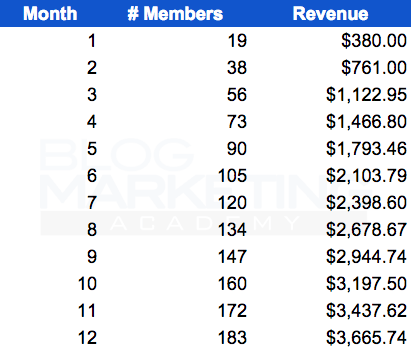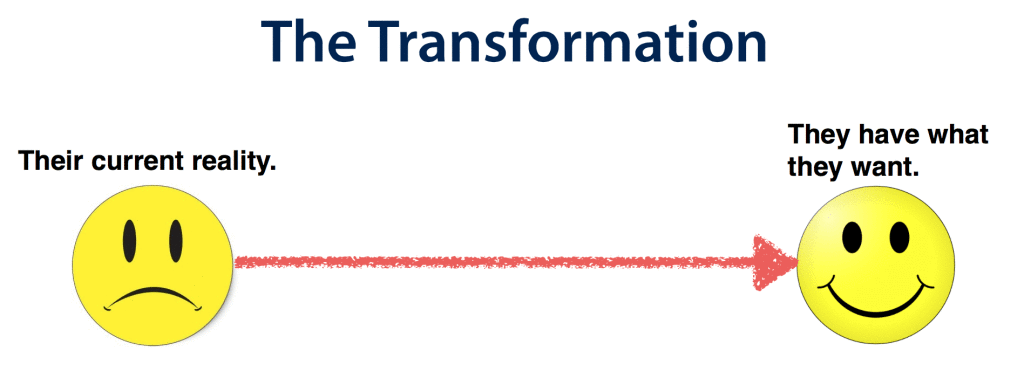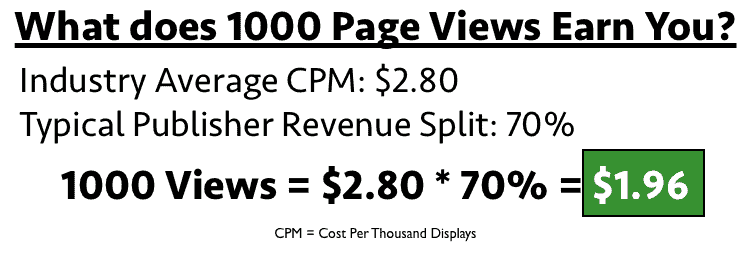For some, monetizing a blog and making real money with it feels like a search for the holy grail. You’re looking for what works, so you spend time looking for the top blog monetization strategies.
The truth is, it used to be easier than it is today.
When I first got into blogging over 20 years ago (before the word “blog” was even a thing, even though that’s exactly what I was doing), it was new and novel to run banner advertising. This was during the big “dot com bubble”. In fact, banner ads were considered such an awesome thing that I even sold my first blog all because the buyer wanted to have all the ad income. (The deal was great… until it wasn’t. You can read the story.)
Today, banner advertising is very different. People are blocking ads because they’re so annoying. And, for bloggers, the numbers aren’t in your favor. With an industry average CPM of $2.80 and publisher splits of 70%, a typical ad banner might make you about two bucks for 1,000 page views.
In my book, that isn’t worth the effort. Or the annoyance.
So, what ARE the best ways to monetize your blog these days?
What works the best? And what isn’t worth your time?
In this post, I’m going to give a summary overview of all of the major ways to monetize your blog. I’m going to rank them in order of effectiveness (as I see it). And I’ll give some advice on each.
Let’s go…
First Things First
To truly understand why the best ways to monetize your blog are indeed the best, you must firmly understand 2 truths:
- A blog is not a business. It is merely a promotional mechanism.
- A blog doesn’t make money. A business does.
So, making money with your blog isn’t a matter of choosing some “technique”.
The word “monetize” gives the impression that you build the blog, THEN you do some series of things to somehow extract money from it. That’s bullcrap. Doesn’t work like that.
You probably have never seen some store owner who built the store, THEN sat there like an idiot and tried to figure out how to “monetize” that space. This is exactly backwards of reality.
The usual ways of monetizing a blog will be found toward the bottom of this list because, more often than not, they’re tacked on after a blog exists already. And it can feel like squeezing juice from a turnip.
However, if you build a BUSINESS (one that actually provides product or service to a real market) and then you use the blog as a marketing medium for it, it works MUCH better.
Ya with me? Making sense? 🙂
Good. So, let’s dive in.
Top Blog Monetization Methods – Ranked In Order
I am going to list out here the primary ways of making money with a blog. I’ve tried my best to rank them in order in terms of income potential combined with relative ease of execution. Of course, that’s a pretty subjective thing.
Let’s start with my favorite…
1. Membership Site
I said above that a blog is not a business. Yet, there is one online business model that really does turn your blog into a business and its own virtual storefront.
The membership site.
It makes perfect sense, too. After all, a blog is a way of distributing content. So, it is just a natural fit to have some content behind a paywall and people need to pay for it. That’s essentially all a membership is.
Now, a membership site can take on a lot of different forms. Many people reactively think that it means a recurring monthly program. That’s one model of it, to be sure. You don’t have to be a recurring membership site, however the revenue can add up pretty nicely. Case in point, let’s look at the numbers of a mythical membership site. This site has the following numbers:
- It costs $20/month.
- It has 5% member churn (which means that, every month, about 5% of the members cancel)
If you enroll just 20 new members monthly (that would be roughly 1 member every 1.5 days), then here’s a rough schedule of your projected income in the first 12 months:

One sale every day and a half of $20, yet it compounds up to the point where you’re generating $3,665.74/month by the end of the first year. And it would just keep on going.
Not all membership sites are recurring. You can sell using any pricing model you like. The point is that they are buying it right there on your site and they need to log into their account in order to access it.
Your content for a membership site can range from a full multi-module course, to single training videos, or even a content upgrade (where members will receive special bonuses on your blog posts, whereas everybody else will see an option to sign up for membership).
The membership site is, by far, my favorite strategy for a blog. The options are endless. And it can truly turn your blog into a revenue factory for you.
[tcb_post_list query=”{‘paged’:1,’filter’:’custom’,’related’:|{||}|,’post_type’:’post’,’orderby’:’date’,’order’:’DESC’,’posts_per_page’:’6′,’offset’:’1′,’no_posts_text’:’There are no posts to display.’,’exclude_current_post’:|{|’1’|}|,’queried_object’:{‘ID’:1105,’post_author’:’1′,’post_type’:’post’},’sticky’:|{||}|,’rules’:|{|{‘taxonomy’:’post’,’terms’:|{|’5751′,’11256′,’11199′,’11198′,’16681′,’11361’|}|,’operator’:’IN’}|}|}” type=”grid” columns-d=”3″ columns-t=”2″ columns-m=”1″ vertical-space-d=”10″ horizontal-space-d=”10″ ct=”post_list-43437″ ct-name=”Small size 04″ tcb-elem-type=”post_list” pagination-type=”none” pages_near_current=”2″ element-name=”Post List” css=”tve-u-16fc9cb4fcb” horizontal-space-m=”0″ total_post_count=”6″ total_sticky_count=”0″ posts_per_page=”6″ featured-content=”0″ disabled-links=”1″ no_posts_text=”” class=” ][tcb_post_list_dynamic_style]@media (min-width: 300px){[].tcb-post-list #post-[tcb_the_id] []{background-image: url(“[tcb_featured_image_url size=full]”) !important;}[].tcb-post-list #post-[tcb_the_id] []{background-image: url(“[tcb_featured_image_url size=full]”) !important;}[].tcb-post-list #post-[tcb_the_id] []{background-image: url(“[tcb_featured_image_url size=full]”) !important;}[].tcb-post-list #post-[tcb_the_id] []{background-image: url(“[tcb_featured_image_url size=full]”) !important;}}[/tcb_post_list_dynamic_style][tcb_post_title css=’tve-u-16fc9cb4fd0′ tcb_hover_state_parent=”][/tcb_post_list]
2. Information Products / Online Courses
While a membership site is really a platform for selling any kind of digital information product, we must allow for other formats.
For instance, some people prefer to sell e-books. Some people prefer to sell their digital products using third-party marketplaces such as Clickbank, JVZoo, E-Junkie, GumRoad or others. All of this is valid.
In the end, the sale of knowledge and online education is huge business. There are big changes afoot in the world of education as we shift away from total reliance on colleges and universities and embrace a growing online cottage industry of on-demand, specialized education. If you have knowledge that other people want, you can participate.
Sites like Udemy give course creators a platform to distribute and sell their own online courses. You would need to use your blog to promote those courses, as you might expect. With Udemy, you need to be very aware of the limitations they place on you, however. You can make money with Udemy, but you need to be strategic in how you use them because many of their rules are not in your favor.
In the end, creating training to help your audience solve the problems they’re looking to your site to solve is good business.
[tcb_post_list query=”{‘paged’:1,’filter’:’custom’,’related’:|{||}|,’post_type’:’post’,’orderby’:’date’,’order’:’DESC’,’posts_per_page’:’6′,’offset’:’1′,’no_posts_text’:’There are no posts to display.’,’exclude_current_post’:|{|’1’|}|,’queried_object’:{‘ID’:1105,’post_author’:’1′,’post_type’:’post’},’sticky’:|{||}|,’rules’:|{|{‘taxonomy’:’post’,’terms’:|{|’11186′,’15408′,’11034’|}|,’operator’:’IN’}|}|}” type=”grid” columns-d=”3″ columns-t=”2″ columns-m=”1″ vertical-space-d=”10″ horizontal-space-d=”10″ ct=”post_list-43437″ ct-name=”Small size 04″ tcb-elem-type=”post_list” pagination-type=”none” pages_near_current=”2″ element-name=”Post List” css=”tve-u-16fc9ecdca4″ horizontal-space-m=”0″ total_post_count=”3″ total_sticky_count=”0″ posts_per_page=”6″ featured-content=”0″ disabled-links=”1″ no_posts_text=”” class=” ][tcb_post_list_dynamic_style]@media (min-width: 300px){[].tcb-post-list #post-[tcb_the_id] []{background-image: url(“[tcb_featured_image_url size=full]”) !important;}[].tcb-post-list #post-[tcb_the_id] []{background-image: url(“[tcb_featured_image_url size=full]”) !important;}[].tcb-post-list #post-[tcb_the_id] []{background-image: url(“[tcb_featured_image_url size=full]”) !important;}[].tcb-post-list #post-[tcb_the_id] []{background-image: url(“[tcb_featured_image_url size=full]”) !important;}}[/tcb_post_list_dynamic_style][tcb_post_title css=’tve-u-16fc9cb4fd0′ tcb_hover_state_parent=”][/tcb_post_list]
3. Services/Consulting/Coaching
In this world of blogging and online marketing, the “sexy” option is to sell digital products. It is laced in dreams of “passive income”.
And in that world, the idea of selling a service might not seem attractive. It is “trading time for money”. And, that’s bad. Right?
Well, truth is offering services is often the fastest and most direct way to make money with your blog.
The reason is simple: No lag time.
If you have the expertise, you can have the idea for a service and essentially be up and running for business within the day. Plus, you can charge higher prices for services or consulting than you can a digital course. Selling a “done for you” service can be quite lucrative.
The whole idea here would be to use your blog as a place to establish your credibility and expertise. You can usually give away much of your best stuff for free for the do-it-yourself crowd because most people still won’t want to actually do it themselves. They can just hire you. 🙂
Bonus points: Combine the sale of services with the sale of information per above. Your blog has a lot of revenue potential this way.
[tcb_post_list query=”{‘paged’:1,’filter’:’custom’,’related’:|{||}|,’post_type’:’post’,’orderby’:’date’,’order’:’DESC’,’posts_per_page’:’6′,’offset’:’1′,’no_posts_text’:’There are no posts to display.’,’exclude_current_post’:|{|’1’|}|,’queried_object’:{‘ID’:1105,’post_author’:’1′,’post_type’:’post’},’sticky’:|{||}|,’rules’:|{|{‘taxonomy’:’post’,’terms’:|{|’13817′,’11725′,’1076’|}|,’operator’:’IN’}|}|}” type=”grid” columns-d=”3″ columns-t=”2″ columns-m=”1″ vertical-space-d=”10″ horizontal-space-d=”10″ ct=”post_list-43437″ ct-name=”Small size 04″ tcb-elem-type=”post_list” pagination-type=”none” pages_near_current=”2″ element-name=”Post List” css=”tve-u-16fc9ded7f3″ horizontal-space-m=”0″ total_post_count=”3″ total_sticky_count=”0″ posts_per_page=”6″ featured-content=”0″ disabled-links=”1″ no_posts_text=”” class=” ][tcb_post_list_dynamic_style]@media (min-width: 300px){[].tcb-post-list #post-[tcb_the_id] []{background-image: url(“[tcb_featured_image_url size=full]”) !important;}[].tcb-post-list #post-[tcb_the_id] []{background-image: url(“[tcb_featured_image_url size=full]”) !important;}[].tcb-post-list #post-[tcb_the_id] []{background-image: url(“[tcb_featured_image_url size=full]”) !important;}[].tcb-post-list #post-[tcb_the_id] []{background-image: url(“[tcb_featured_image_url size=full]”) !important;}}[/tcb_post_list_dynamic_style][tcb_post_title css=’tve-u-16fc9cb4fd0′ tcb_hover_state_parent=”][/tcb_post_list]
4. Affiliate Marketing
Affiliate marketing is a great way to build up your income. In fact, for a lot of blog owners, this is the most popular and compelling way to go.
People buy a product via your personal affiliate link and you earn a commission. It is attractive to many people because:
- You don’t have to make the product yourself.
- No fulfillment or support issues to deal with.
- You see other big-name bloggers doing it and it seems easy.
But, let’s be clear, relying on affiliate marketing as your business model isn’t all fun and games. It can be a lot harder than it looks. You have very little control over the sales process itself. Plus, in some markets, there is just a severe shortage of decent products that you can promote, feel good about, and still make a decent commission.
This is why I say that any form of direct sale of your own offer (which includes strategies 1-4 above) is preferable to affiliate marketing. I personally prefer to use affiliate marketing as a profit maximizer for my business. I make money this way, but it isn’t the core of my business.
Your best bet to be successful with affiliate marketing is to treat anything you promote as if it were your own product.
Never promote something only for the commission, but only do so if it represents a REAL solution that enables the transformation you deliver. Your blog should be based around enabling somebody to make a transformation from some “before state” to a new “after state”, in context of whatever you do.

You look for the typical barriers that will come up during this transformation and you find those products that best get them where they want to go. And you provide helpful content to enable that transformation, with the product you’re promoting being a means to that end.
5. Ecommerce Sales/ SAAS
We’ve talked about information/training products and services, but let’s not dismiss the sale of “real world” products. This could include digital products such as software, SAAS (software as a service), or even physical ecommerce.
Software as a service (or SAAS) is an incredibly great business model. You solve a problem for some niche of people using a custom software program (usually web-based) and you sell it to them. If you can bill for it using a recurring model, then you have a built-in revenue stream. And in many ways, it is better than a membership training site because software has the inherent promise of instant results whereas training requires upfront work before you get the result. I personally know several old-time bloggers who have evolved over the years into SAAS and now have six and seven figure businesses.
Nathan Barry switched from blogging and online training and decided to start a software company you now know as ConvertKit.
Laura Roeder was in the same game for awhile, then founded MeetEdgar.
In most ways, a SAAS business is a superior business model than the others on this list. The only reason I list it at #5 is because it is a more difficult model for most people. You either need the coding skills yourself or you need to partner with the right people. But, logistics aside, it is a great business model.
We also can’t forget ecommerce, where the purpose is to sell “real world” goods that get shipped to people. This is certainly not my area of expertise, but it is a multi-billion dollar business. Just look at Amazon. Derek Halpern, from Social Triggers, is one good example of a blogger who now runs an ecommerce business Truvani.
Now, on the surface, these models might not seem to have much to do with a blog. But, when we began, I said that a blog is not a business. It is a promotional medium. This means that a blog can make an AWESOME platform to promote either a SAAS business or even an ecommerce business.
In the end, we always must approach monetization from the perspective of solving people’s problems. If that solution comes in the form of software or a physical product, so be it. Either way, the blog is a powerful way to get the word out, and the options that gives you even if using paid advertising are through the roof.
6. Speaking Gigs

Your’s truly speaking back when I actually cared to speak at conferences. 🙂
If you become well known as an expert in your niche, you can turn that into speaking gigs which you get paid for. The purpose of your blog is to position yourself as an expert and gifted communicator, but then your target customer will be event organizers.
This option isn’t for everybody since many people aren’t great speakers and/or wouldn’t feel comfortable doing this kind of thing. That said, speaking can be potentially lucrative and it is still an offer which you are providing directly.
The “trick” here is to keep in mind who your real customer is. Your customer, in this case, is the event organizer. That person wants to have solid content for their event and they want butts in the seats. The best speakers, for them, will be the ones who are good speakers and can help fill the seats.
So, you should be spending your time branding yourself online, building your own distribution assets (your blog, your social channels, your email list). Maybe even have a book in your name. And, you should have a page on your site which sells you as a speaker. Show a speaking reel of yourself speaking at other events, testimonials from other event organizers.
YOU are the product here. Sell it.
7. Banner Advertising
The good ol’ banner ad. Everybody hates it. People block it. Yet, bloggers like to rely on it as the one-trick pony to monetize their blog.
Despite being the most popular strategy for blog monetization, there’s a reason it ranks way down here at #7 in terms of effectiveness. This is because, for most, it simply doesn’t result in much revenue.
For banner ads to turn into a solid revenue source, you need a LOT of traffic. Traffic that, if you had monetized it in a more direct way, you would have been making more money much sooner.
Let’s look at what 1,000 page views can earn you with pretty typical numbers:

Yep, about two bucks. And yes, you can probably get that number up by throwing more banners on the same page and generally getting more annoying. But, is that really worth it?
The reason for this is because banner advertising is in direct violation of some of our own goals as blog owners. We do all this work to attract traffic to our blogs, only to send them away again through a banner ad. Usually only to earn a few cents in return.
Plus, you’re not adding any VALUE. Most of the times, the ads being shown are for competing products. They compete for your visitor’s attention when they should have their attention on YOUR stuff. They provide no value (nobody ever said they were happy to see a banner ad). Many people block them or simply tune them out. And because advertisers know this, they sometimes resort to flashier ads that just assault your eyeballs.
All that said, banner ads can be a revenue generator. I’ve certainly done it (in my prior business in the tech niche). But, I think it should only be used heavily if you’re in a niche which has few other options. Some markets don’t lend themselves to a transformation (see the graphic above). Examples are markets like politics, celebrity, news, opinion. These kinds of markets mean you usually have to fall back on advertising as your monetization strategy.
[tcb_post_list query=”{‘paged’:1,’filter’:’custom’,’related’:|{||}|,’post_type’:’post’,’orderby’:’date’,’order’:’DESC’,’posts_per_page’:’6′,’offset’:’1′,’no_posts_text’:’There are no posts to display.’,’exclude_current_post’:|{|’1’|}|,’queried_object’:{‘ID’:1105,’post_author’:’1′,’post_type’:’post’},’sticky’:|{||}|,’rules’:|{|{‘taxonomy’:’post’,’terms’:|{|’11117′,’14557′,’10350’|}|,’operator’:’IN’}|}|}” type=”grid” columns-d=”3″ columns-t=”2″ columns-m=”1″ vertical-space-d=”10″ horizontal-space-d=”10″ ct=”post_list-43437″ ct-name=”Small size 04″ tcb-elem-type=”post_list” pagination-type=”none” pages_near_current=”2″ element-name=”Post List” css=”tve-u-16fca07181d” horizontal-space-m=”0″ total_post_count=”3″ total_sticky_count=”0″ posts_per_page=”6″ featured-content=”0″ disabled-links=”1″ no_posts_text=”” class=” ][tcb_post_list_dynamic_style]@media (min-width: 300px){[].tcb-post-list #post-[tcb_the_id] []{background-image: url(“[tcb_featured_image_url size=full]”) !important;}[].tcb-post-list #post-[tcb_the_id] []{background-image: url(“[tcb_featured_image_url size=full]”) !important;}[].tcb-post-list #post-[tcb_the_id] []{background-image: url(“[tcb_featured_image_url size=full]”) !important;}[].tcb-post-list #post-[tcb_the_id] []{background-image: url(“[tcb_featured_image_url size=full]”) !important;}}[/tcb_post_list_dynamic_style][tcb_post_title css=’tve-u-16fc9cb4fd0′ tcb_hover_state_parent=”][/tcb_post_list]
8. Paid Posts / Sponsorships
Want to be an “influencer”? It seems to be the thing to do for millennials. And there’s no doubt that it can be lucrative if you’ve got the following.
The truth is that blogs are a powerful branding tool. And in some markets (like moms), there are large brands created by women who simply don’t sell anything, yet they have a fair amount of influence. So, for companies who want to promote themselves, it makes a lot of sense to approach these bloggers and strike a deal to get them to talk.
A sponsorship deal can work out really well depending on the nature and size of your audience. You work out a deal with the sponsor, they pay you. And then you mention that you are sponsored by them, likely put some ads for them around your site, talk about them sometimes, etc.
If you develop a podcast with a good-size listener audience, sponsorship deals like this can work out well. Industry averages run around $15-20 for a 15-second pre-roll for 1,000 listens.
Sponsored posts is where you are actually paid directly to write a blog post about some product or company. Rates for this kind of thing vary alot depending on the blogger, their audience size, etc. You can check out this post over at Successful Blogging for more about how to manage your sponsored posts.
The whole “influencer” game is an option, too, if your audience is primarily on social media and not so much centered on your blog. Klear has an interesting survey showing average prices for posts:

If you’re going to sell paid posts, my advice is to look at it more as a package deal. Consider your social channels, your email list and your blog. Set up bundles which provide the advertiser varying levels of exposure. Essentially, this is paid advertising, but you’re the direct provider. And depending on your level of influence, you can charge hefty fees for this.
But, always bear in mind, my advice is to always look for opportunity for direct solutions for your readers first (see options #1 and #2 above). I’ve seen many mommy bloggers who shy away from sales because they’re afraid to be seen as “salesy”, yet they’ll resort to shilling for other companies in a paid post. Seems… ironic. 😉
9. Freelance Writing
There are a lot of blogs out there in need of good, solid content. Nobody said it had to be YOUR blog. 🙂
So, one way to go is to blog as a way of perfecting your skills as a writer. Learn how to craft engaging content that draws traffic and gets an audience involved. THEN…
Market yourself as an on-demand freelance blogger.
Many small businesses and companies that have blogs don’t have the time, resources of skillset to create truly compelling content. And it can be worth it to them to pay somebody else – like you – to do it for them.
Content marketing, as a career, is definitely no slouch. PayScale estimates the average salary for a content marketer (as an employee, mind you), is close to $52,000. But, freelance blogging can potentially do even better. Elna charges about $250 per post. Carol Tice makes $5,000/month doing freelance writing.
10. Taking Donations
One way to make money from your audience – even without necessarily selling them any particular thing – is to enable them to make donations.
Non-profits do this all the time. There are also numerous plugins to allow accepting donations on a Wordpress blog, such as Give, Charitable, or Paypal Donation.
Some sites take this model to the next level by offering some additional value specifically for their supporters. One way to do this is by using Patreon. This is like a form of membership site, yet not really oriented around online training, but more as a way to support content they love.
I’ve seen numerous travel blogs, for instance, monetize (in part) through a Patreon community. Sites like Gone With The Wynns have a few member levels via Patreon. Another example is SV Delos which has some member levels on Patreon as well. The Delos crew also has a “Buy Us As Beer” donation page which provides the option for a one-time donation via Paypal in addition to their Patreon options.
This option is most suitable, in my opinion, for personality or lifestyle audiences. Content that people want to follow and live vicariously through you. Give them content that helps take the boredom out of their lives.
Typically, this monetization strategy will be used in conjunction with others, such as ads and affiliate marketing.
11. Build It & Sell It (aka Flipping)

You can build up a blog, build an audience, then turn around and sell the thing.
In fact, some people actually buy blogs which are dead or are vastly underutilized by their owners. A sort of “fixer upper”. They’ll then put their marketing skills to work, build the SEO backlinks, build the readership. Then, they turn around and sell it at a profit. It can work.
Keep in mind, selling a website isn’t nearly as predictable as something like real estate. On Flippa, the averaging starting price for a listing is $2,223, however the average actual selling price is only around $656. The median number is just $115. So, what you ask is often nowhere near what you’ll actually get for it.
There are certain smart things one should do so increase the sales price. It comes down to increasing revenue, profit and traffic. Those are the big 3 things that matter.
If you’re going to do this and add real value in the process, then I would focus more on possibly acquiring blogs which have traffic, but yet it is clear the owner doesn’t have the time for it. They probably have a little guilt associated with not maintaining that site. They also likely never thought they could sell it and make any money. So, you can approach them and offer to buy it and say you’ll run it and provide a lot of value to the community. From their perspective, it can be a win-win. You then work your magic, build the site into a more effective marketing platform and then turn around and sell it to somebody else. You’re providing real value, enhancing a property people like, and profiting in the process.
But, let’s also be real…
If you do the work to increase the potential value of a web property, you might want to just keep it for yourself. 🙂
So, What Now?
If I had to guess, you arrived at this post because you’re at the very beginning of thinking about making money with your blog. You’re trying to figure out the best way forward.
It can seem complicated. Even overwhelming. But, it honestly isn’t. It simply comes down to understanding the true purpose of the blog and then utilizing the right blueprint to build up what you intend to build.
I have a pathway mapped out. You can download it for free. The actual training that goes behind it is reserved for paid members of THE LAB, but you can sign up for a free account and download our Roadmap, plus some other goodies.
Got A Question? Need Some Assistance?
Have a question about this article? Need some help with this topic (or anything else)? Send it in and I’ll get back to you personally. If you’re OK with it, I might even use it as the basis of future content so I can make this site most useful.



